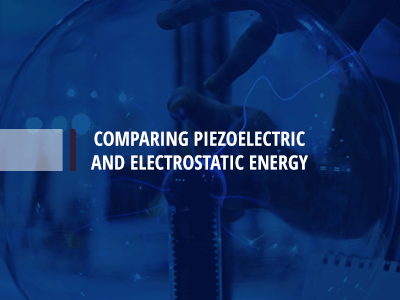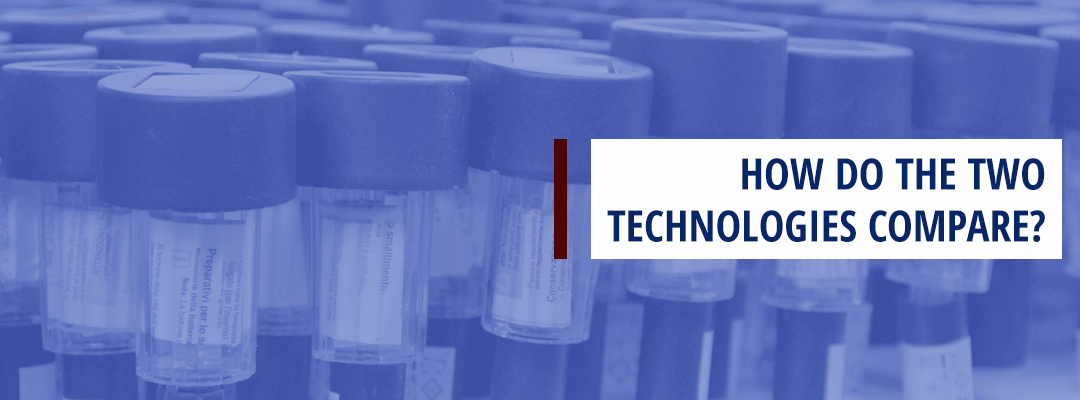Comparing Piezoelectric and Electrostatic Energy

Harvesting energy from renewable sources has gained a great deal of traction in recent years. From environmental concerns to resource scarcity, there are many reasons to look for non-conventional sources of energy. While large-scale energy sources like wind turbines have gained a great deal of attention, smaller-scale energy sources are quietly making headway as alternatives or augmentations for batteries and plugins. Even though these small-scale energy sources create relatively small amounts of power, many low-power applications can use these small energy harvesting technologies.
The Growth of Energy Harvesting Mechanisms
Energy harvesting, also called energy scavenging, is the act of collecting small quantities of ambient energy and converting it into electrical energy to power autonomous electronic devices and circuits. In theory, energy harvesting is similar to the concept of renewable energy, like wind energy, where wind turbines harvest mechanical energy from the environment and convert it into electrical energy. Energy harvesting, however, takes this idea and applies it to a very small scale.
Energy harvesting typically produces small amounts of energy ranging from tens of microwatts to a couple of watts, which may be immediately used or stored for later use. While this may not seem like much, this technology is being explored for a variety of applications where batteries are either impractical or limited in use. Some examples of energy harvesting applications include the following:
– Remote monitoring systems
– Implantable devices
– Equipment monitoring
– Electronic textiles
In short, energy harvesting is a promising technology for a wide range of applications where batteries are impractical. As technology continues to improve, energy harvesting technology is expected to grow in popularity and demand.
But where does energy harvesting get its energy? While thermoelectric and electromagnetic harvesting devices are being explored, the most significant energy harvesting devices collect piezoelectric and electrostatic energy.
An Overview of Piezoelectricity
Piezoelectricity, also called the piezoelectric effect, is the generation of electrical potential from a crystal when the crystal is subjected to mechanical stress. When placed under mechanical stress, the crystal develops a positive charge on one face and a negative charge on the opposite face, creating a current when connected.
Piezoelectricity is based on crystals, which are defined as any solid whose atoms or molecules are arranged in endless repetitions of the same unit cell. While quartz fits this definition, so do other materials like iron. The quality that differentiates piezoelectric crystals is that their unit cells aren’t symmetrical. While their electrical charges are balanced, their structures make it so that when squeezed, the structure deforms in a way that the positive charges and negative charges in the unit cell are moved. This movement of charges creates net electrical charges seen on each face.
Piezoelectricity also works in reverse — if a piezoelectric crystal has a current run through it, it will work to rebalance the electrical charges within. This causes the crystal to deform when a voltage is placed across it.
What Is Electrostatic Energy?
Electrostatic energy is based on electric potential energy, which is the capacity to do work based on position and configuration. Imagine that there is a large, negatively charged object with a small, positively charged object stuck on it. The amount of force required to pull the positive particle off of the negative plate is stored within the particle as electrical potential energy. If the particle and the plate are set in a fixed, separated position, the potential energy in the system is called electrostatic energy.
How Do the Two Technologies Compare?

Both piezoelectric and electrostatic energy can be harvested using unique technologies, but they are patently different in how they are designed. Below is an overview of how the two technologies work and how they compare:
1. Harvesting Piezoelectricity
Piezoelectricity is harvested through the use of piezoelectric transducers. The crystal in a piezoelectric system creates electricity when subjected to any type of kinetic energy, including pressure or vibration. The transducer then takes this energy and directs it to be rectified and regulated, preparing it for storage or use.
2. Harvesting Electrostatic Energy
Electrostatic energy is harvested by harnessing the potential energy within a parallel plate capacitor. The capacitance in this system changes as the system vibrates — when the capacitor plates separate, the capacitance decreases, which causes the voltage to increase in the system. This creates a charge, which is then directed to the batteries connected to the system, storing the energy created in the system.
3. Piezoelectricity vs. Electrostatic Energy
Both piezoelectric and electrostatic energy harvesters work by converting vibrational energy into electrical energy, though they do so in different ways. There are many other ways in which these technologies differ, including:
– Charge produced: Electrostatic energy harvesters tend to produce less energy overall than piezoelectric harvesters.
– Preferred acceleration: Piezoelectric devices tend to work better in applications where the acceleration is middling — these devices are less effective at picking up low acceleration, and tend to be limited at very high accelerations. Electrostatic energy harvesting devices are less effective than piezoelectric devices for the majority of middling accelerations but operate better than piezoelectric devices at very low and very high accelerations.
– Materials: Piezoelectric harvesting systems require exotic crystal materials for the transducers, while electrostatic energy harvesters work with more traditional, easy-to-access materials.
Common Applications of Piezoelectricity and Electrostatic Energy
While piezo and electrostatic energy may seem advanced, technologies that use these types of energy are already in common use today. Some examples of devices using piezoelectric and/or electrostatic energy include:
– Piezoelectric floor tiles: Floor tiles and sidewalks outfitted with piezoelectric transducers are currently being used to power displays, emergency lighting, heating and other basic functions.
– Pressure sensors: Many car tires are outfitted with energy harvesting sensors that monitor tire pressure and transmit data to the automobile’s central system.
– Medical implants: Some novel pacemakers and implanted defibrillators are outfitted with piezoelectric and electrostatic harvesting devices that convert the vibrational energy of heartbeats into energy to power the implants.
As technology advances, many expect to see piezoelectric and electrostatic energy harvesting technology expand over time as a small-scale source of renewable energy.
Choosing Between Piezoelectric and Electrostatic Energy
When considering whether to use piezoelectric or electrostatic energy harvesters, it is essential to consider the application in which the system will be used. The best way to do this is to model the accelerations involved in an application and consider the optimal operating conditions of piezoelectric vs. electrostatic harvesting technologies.
For the vast majority of applications, vibrations occur with a range of accelerations, with the majority of accelerations occuring within the middle range. This middle range is where piezoelectric harvesting is most effective. While electrostatic energy is better at picking up extremely high or low accelerations, it is less effective than piezoelectric devices at generating energy for the middle range.
Choose APC International
If your company is interested in harnessing the power of piezoelectricity, APC International is here to provide quality transducers, devices and support services.
Since 1986, APC has manufactured high-quality custom piezo products for our clients, including ceramics, actuators, transducers, nebulizers, ignitors, sensors and other devices. Our experienced team and superior customer service make us the supplier of choice for companies worldwide. On top of it all, we offer excellent prices and one-week delivery, a combination unheard of in the piezo industry.
Related Articles From APC International
- What Is The Purpose Of A Piezo Motor
- Piezo Aiding Advancements In The Healthcare Industry
- Comparing Piezoelectric And Electrostatic Energy
- Self-Charging Power Cells And Batteries: What Are They?
- The Piezoelectric Effect: Technology Generates Functional Benefits
- Piezoelectricity & Wearable Technology: The Future of Piezoelectric Components
If you’re interested in learning more about how APC can help your company with quality piezo products and services, contact APC today.



No Comments